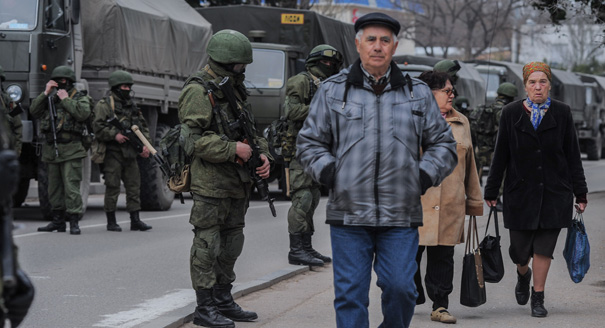
Crimea: From Russian Putsch to Military Invasion and Possible Occupation
Publication: Eurasia Daily Monitor Volume: 11 Issue: 41
By:

President Vladimir Putin announced today (March 4) that Russia’s ground troops, deployed across Crimea since March 1, have “reinforced the protection of our installations” (“obiekty”) on that territory of Ukraine. The Russian president’s remarks neither acknowledge nor dispute Ukraine’s sovereignty in Crimea. However, Putin depicted Ukraine’s new government explicitly as illegitimate (Interfax, March 4).
Putin’s phrasing implies that the ground troops’ deployment is modest in scale; and that those troops could stay in Crimea as long as Russia deems necessary, without officially de-recognizing Ukraine’s sovereignty. Such ambiguities seek to inhibit or delay international reactions, until the military occupation and Russian-installed secessionist authorities become faits accomplis. Then Crimea would add to South Ossetia, Abkhazia, or Transnistria as de facto possessions of Russia.
Russia’s ground-force operation developed from a military-political putsch, executed on February 27–28 in the Crimean Autonomous Republic on Ukraine’s territory. Heavily armed Russian special troop squads seized Crimea’s key logistical centers and main administrative institutions. Under those troops’ protection, local Russian nationalist politicians took over the Crimean autonomy’s government, the Sevastopol municipality, and other seats of power. Crimea’s authorities had traditionally worked loyally with Ukraine’s central government, but this new group will not. Moscow will undoubtedly use it to cause difficulties for the newly installed, pro-Europe government in Kyiv (see EDM, February 28).
The putsch turned out to be the first stage in a wider, phased operation. From March 1 it developed seamlessly into its second phase: an invasion by Russian ground troops across the Crimean peninsula. These movements were staged as part of exercises that encompassed much of European Russia. By including Crimea in this exercise, the Kremlin demonstrated that it can negate Ukrainian sovereignty in practice.
This second phase seemed at the outset designed to draw locally based Ukrainian forces into clashes, which from Moscow’s point of view should ideally involve collateral civilian casualties. Russia could, in that case, move to a third phase in which it would ignite civil conflict beyond Crimea, in mainland Ukraine.
That intent is clearly apparent in Russian state television broadcasts targeting Ukraine in the wake of regime change in Kyiv. The three Russian state TV channels crudely labor to spark conflicts in Ukrainian society along political, ethnic, linguistic and confessional lines (Russian Television Channel One, Rossiya TV, NTV, February 22–March 3).
The Ukrainian government has made no secret of its fears that Moscow could use a version of the 2008 Georgia scenario, which started with wider exercises of Russian forces around that country. The intrusion of Russian forces in Crimea started as part of wider Russian exercises around Ukraine. Military clashes in Crimea, or violent strife such as Moscow seeks to incite in mainland Ukraine, could serve to justify a Russian-assisted “liberation” of parts of Ukraine, with the political objective of regime change in the country.
That would be hypothetically the fourth, final phase of Russia’s military-political operation, the first two phases of which have been consummated in Crimea. Were Ukrainian troops in Crimea to shoot back in self-defense, Russia could presumably exploit such incidents and escalate to the next phase, directly into Ukraine.
Such appears to have been the Ukrainian government’s reasoning, at least until March 3, as its public statements indicate. Avoidance of provocations seems to have been the underlying imperative on Kyiv’s part; and this is not changing (UNIAN, Interfax, February 27–March 4).
Accordingly, the Ukrainian government and military command apparently ordered Ukrainian forces in Crimea to not interfere with Russian troop movements; to stay confined within the perimeters of their own stations; and resort only to negotiation, not force, if Russian troops attempt to enter those stations or disarm the Ukrainian units therein.
Starting on March 1, Russian troops landed in Crimea at multiple locations by air and sea. Land-mobile troop columns crisscrossed the peninsula unimpeded. They stopped to position themselves aggressively outside Ukrainian command headquarters, infantry barracks, military airfields, coastal guard anchorages, and communications stations.
Russian troops variously surrounded these Ukrainian sites, or blocked access to them, or posted guards on their perimeter. The Russians then demanded to enter and inspect these Ukrainian units and to seize their arms and ammunition. This they proceeded to do in most cases, without consent but also without active opposition from the Ukrainians. Not content with that, Russians smashed communications gear, computers and other inventory of the Ukrainian military sites (Interfax-Ukraine, UNIAN, Ukrainska Pravda, Channnel 5 TV, March 1–4).
The Ukrainian units acted apparently under strict orders from Kyiv (see above) not to shoot or otherwise attempt physical resistance. Instead, local Ukrainian commanders attempted to negotiate with the Russians. Negotiation achieved the purpose of avoiding clashes at all cost. Some Ukrainian coastal guard vessels relocated to Mariupol (Azov Sea, Donetsk oblast) and to Odessa, averting possible capture at their Crimean anchorages.
There is a crucial distinction to be made between Russia’s Black Sea Fleet, stationed in Crimea under a Russian-Ukrainian treaty, and which includes some ground troops attached to it, on the one hand; and Russia’s ground troops that entered Crimea with this exercise, on the other hand. Under Ukraine’s constitution, any deployment or passage of foreign troops on Ukraine’s territory requires the consent of parliament on a case-by-case basis. Russia is not known to have requested such consent, and Ukraine’s parliament certainly did not grant it.
Putin’s March 4 claim (see above) to be “reinforcing the protection of Russian installations” with these additional troops must be assessed also in that light. Any Russian troops other than those of Russia’s Black Sea Fleet would be nothing but occupation troops, introduced into Ukraine’s territory illegally.




